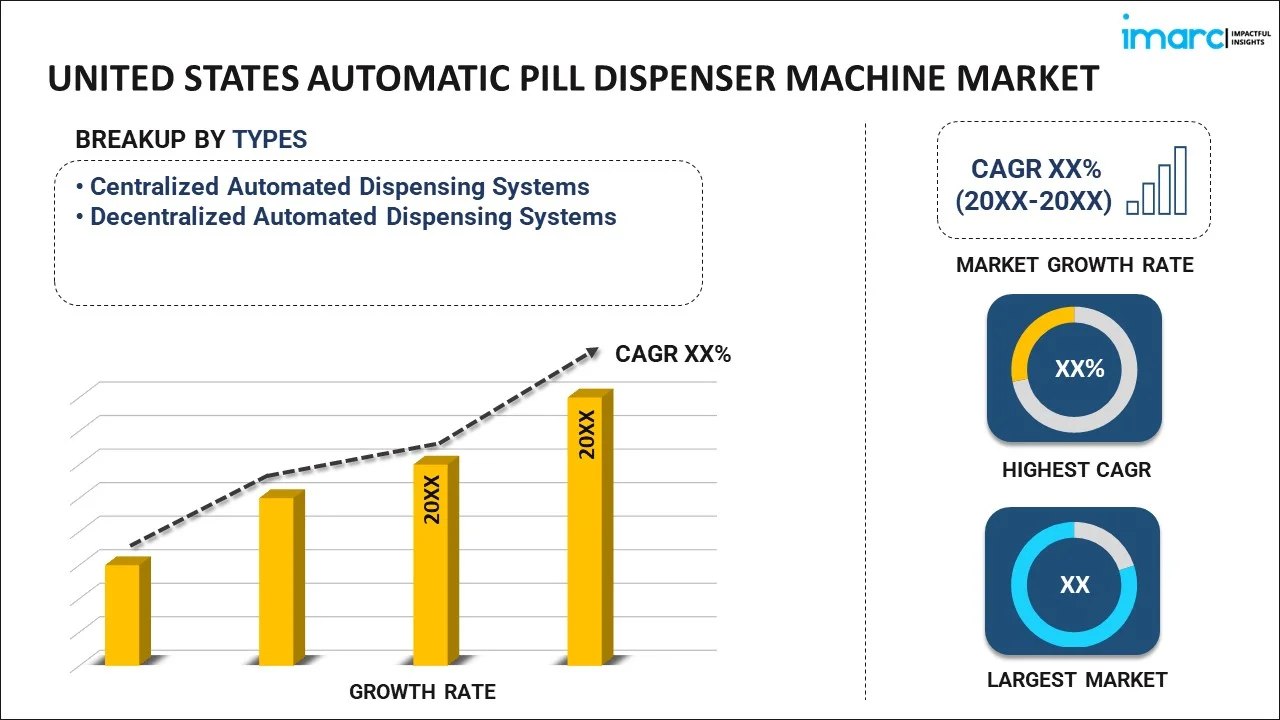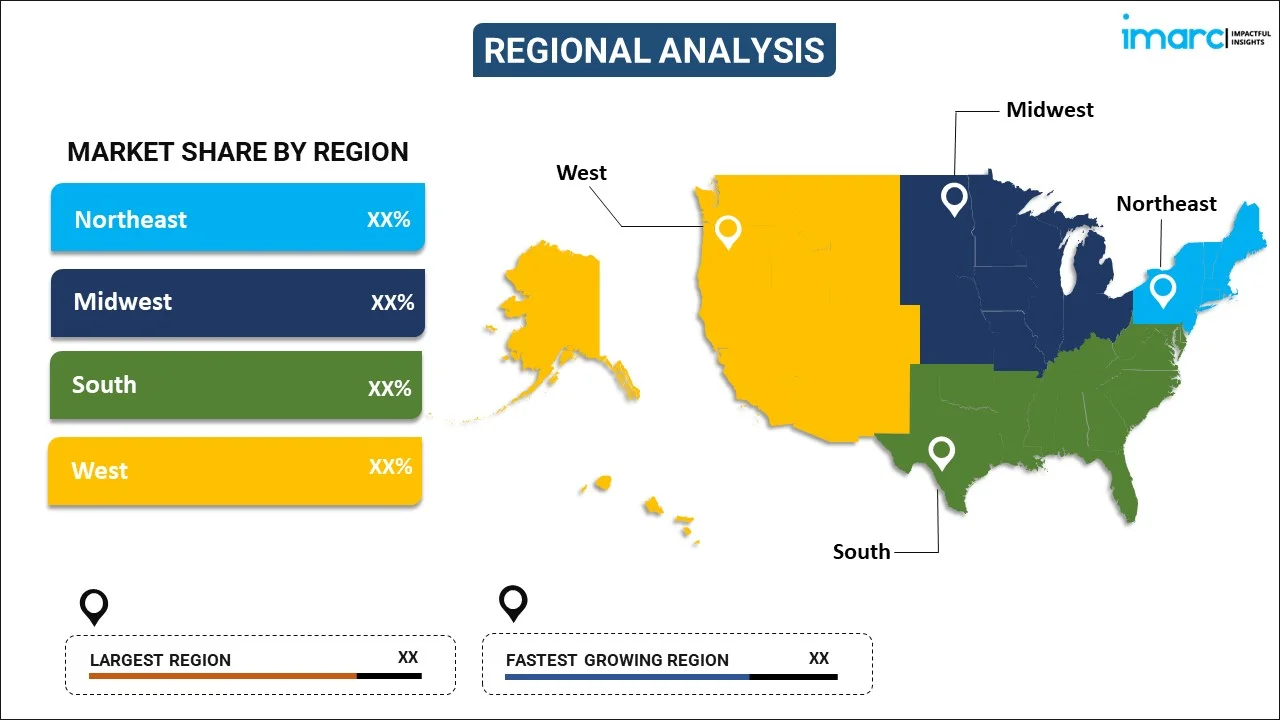
United States Automatic Pill Dispenser Machine Market Report by Type (Centralized Automated Dispensing Systems, Decentralized Automated Dispensing Systems), Application (Hospital Pharmacy, Retail Pharmacy, Home Healthcare), and Region 2025-2033
Market Overview:
United States automatic pill dispenser machine market size reached USD 974.2 Million in 2024. Looking forward, IMARC Group expects the market to reach USD 1,896.0 Million by 2033, exhibiting a growth rate (CAGR) of 7.68% during 2025-2033. Burgeoning elderly population, the escalating prevalence of chronic diseases, technological advancements in smart dispensers, the rise of telehealth, increased awareness of medication adherence, surging collaborative partnerships, and the integration of artificial intelligence (AI) and machine learning (ML) are contributing to the market growth.
|
Report Attribute
|
Key Statistics
|
|---|---|
|
Base Year
|
2024 |
|
Forecast Years
|
2025-2033 |
|
Historical Years
|
2019-2024
|
| Market Size in 2024 | USD 974.2 Million |
| Market Forecast in 2033 | USD 1,896.0 Million |
| Market Growth Rate (2025-2033) | 7.68% |
An automatic pill dispenser machine is a sophisticated medical device designed to facilitate the organized and timely administration of medications to patients. They are manufactured using a combination of advanced technologies, including robotics and electronic components, to ensure precise and reliable medication dispensing. They are typically constructed with durable materials such as plastic and metal to withstand regular use in clinical settings. Automatic pill dispensers serve a crucial role in healthcare by reducing the risk of medication errors and improving medication adherence. They are primarily used in hospitals, long-term care facilities, and home healthcare settings. They are programmable to dispense specific medications at pre-determined times, ensuring that patients receive their prescribed doses accurately and on schedule. This is particularly beneficial for individuals with complex medication regimens or those who may have difficulty remembering to take their medications as prescribed. The advantages of automatic pill dispensers are manifold, such as they enhance patient safety by minimizing the likelihood of dosage errors, which can have serious consequences. They also promote medication adherence, which is essential for the effectiveness of treatment plans. Patients are more likely to follow their prescribed medication regimens when using these devices. Additionally, automatic pill dispensers can be remotely monitored by healthcare professionals, allowing for real-time tracking of patient medication adherence and enabling timely interventions when necessary. Furthermore, they can store and dispense multiple medications, making them suitable for patients with various medical conditions.
United States Automatic Pill Dispenser Machine Market Trends:
The United States automatic pill dispenser machine market is influenced by several key drivers, such as the rising elderly population in the country, which has increased the demand for convenient medication management solutions. Automatic pill dispensers offer a user-friendly approach to ensure that seniors can adhere to their medication regimens effectively. In line with this, the growing prevalence of chronic diseases, such as diabetes and hypertension, has necessitated a more efficient and reliable way of dispensing medications on schedule, which is creating a positive outlook for the market. Moreover, advancements in technology have led to the development of smart and connected automatic pill dispensers, which is favoring the market growth. This connectivity not only enhances convenience but also enables healthcare providers and caregivers to track medication adherence more closely, making it a valuable tool in telehealth and remote patient monitoring. Apart from this, the ongoing COVID-19 pandemic has accelerated the adoption of telemedicine and home healthcare solutions, which is stimulating the market growth in the country.
United States Automatic Pill Dispenser Machine Market Segmentation:
IMARC Group provides an analysis of the key trends in each segment of the market, along with forecasts at the country level for 2025-2033. Our report has categorized the market based on type and application.
Type Insights:

- Centralized Automated Dispensing Systems
- Robots and Robotic Automated Dispensing Systems
- Carousels
- Decentralized Automated Dispensing Systems
- Pharmacy-Based Automated Dispensing Systems
- Ward-Based Automated Dispensing Systems
- Automated Unit Dose Dispensing Systems
The report has provided a detailed breakup and analysis of the market based on the type. This includes centralized automated dispensing systems (robots and robotic automated dispensing systems and carousels) and decentralized automated dispensing systems (pharmacy-based automated dispensing systems, ward-based automated dispensing systems, and automated unit dose dispensing systems).
Application Insights:
- Hospital Pharmacy
- Retail Pharmacy
- Home Healthcare
A detailed breakup and analysis of the market based on the application have also been provided in the report. This includes the hospital pharmacy, retail pharmacy, and home healthcare.
Regional Insights:

- Northeast
- Midwest
- South
- West
The report has also provided a comprehensive analysis of all the major regional markets, which include the Northeast, Midwest, South, and West.
Competitive Landscape:
The market research report has also provided a comprehensive analysis of the competitive landscape in the market. Competitive analysis such as market structure, key player positioning, top winning strategies, competitive dashboard, and company evaluation quadrant has been covered in the report. Also, detailed profiles of all major companies have been provided.
United States Automatic Pill Dispenser Machine Market Report Coverage:
| Report Features | Details |
|---|---|
| Base Year of the Analysis | 2024 |
| Historical Period | 2019-2024 |
| Forecast Period | 2025-2033 |
| Units | Million USD |
| Scope of the Report | Exploration of Historical and Forecast Trends, Industry Catalysts and Challenges, Segment-Wise Historical and Predictive Market Assessment:
|
| Types Covered |
|
| Applications Covered | Hospital Pharmacy, Retail Pharmacy, Home Healthcare |
| Regions Covered | Northeast, Midwest, South, West |
| Customization Scope | 10% Free Customization |
| Post-Sale Analyst Support | 10-12 Weeks |
| Delivery Format | PDF and Excel through Email (We can also provide the editable version of the report in PPT/Word format on special request) |
Key Questions Answered in This Report:
- How has the United States automatic pill dispenser machine market performed so far and how will it perform in the coming years?
- What has been the impact of COVID-19 on the United States automatic pill dispenser machine market?
- What is the breakup of the United States automatic pill dispenser machine market on the basis of type?
- What is the breakup of the United States automatic pill dispenser machine market on the basis of application?
- What are the various stages in the value chain of the United States automatic pill dispenser machine market?
- What are the key driving factors and challenges in the United States automatic pill dispenser machine?
- What is the structure of the United States automatic pill dispenser machine market and who are the key players?
- What is the degree of competition in the United States automatic pill dispenser machine market?
Key Benefits for Stakeholders:
- IMARC’s industry report offers a comprehensive quantitative analysis of various market segments, historical and current market trends, market forecasts, and dynamics of the United States automatic pill dispenser machine market from 2019-2033.
- The research report provides the latest information on the market drivers, challenges, and opportunities in the United States automatic pill dispenser machine market.
- Porter's five forces analysis assist stakeholders in assessing the impact of new entrants, competitive rivalry, supplier power, buyer power, and the threat of substitution. It helps stakeholders to analyze the level of competition within the United States automatic pill dispenser machine industry and its attractiveness.
- Competitive landscape allows stakeholders to understand their competitive environment and provides an insight into the current positions of key players in the market.
Need more help?
- Speak to our experienced analysts for insights on the current market scenarios.
- Include additional segments and countries to customize the report as per your requirement.
- Gain an unparalleled competitive advantage in your domain by understanding how to utilize the report and positively impacting your operations and revenue.
- For further assistance, please connect with our analysts.
 Inquire Before Buying
Inquire Before Buying
 Speak to an Analyst
Speak to an Analyst
 Request Brochure
Request Brochure
 Request Customization
Request Customization




.webp)




.webp)












